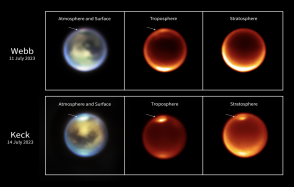The SEIS seismometer delivers the first seismic and acoustic waves from a meteorite impact on Mars
Before NASA’s InSight mission, details of the internal structure of Mars and the depth of the boundaries between crust, mantle and core were relatively imprecise. Furthermore, impact cratering is a fundamental process that shapes planetary surfaces and atmospheres. Recent impactors form new craters and excite acoustic and seismic waves as they enter the atmosphere and impact the ground. They can therefore be detected by both the SEIS seismometer and the imagers orbiting Mars.
To date, the seismometer onboard InSight has identified and located four impacts on the surface of Mars. To do this, the sound waves emitted by the impacts have been detected by the tiny deformations in the ground that they produce as they pass over the seismometer. The arrival times and polarisation of the seismic and acoustic waves were then used to estimate the locations of the impacts.
These observations, which are the first known on a planet other than Earth, were confirmed by orbital imagery of the associated craters. The dimensions of the craters and estimates of the meteorite trajectories make it possible to understand and model the seismograms recorded. By knowing the location of these sources, the impacts detected can be used to image the Martian interior. The first arrivals of seismic waves confirm the models of the crust previously determined.
“Knowing the structure of the crust of Mars and its level of heterogeneity allows us to learn more about its evolution over the years. We need to understand that it is at the heart of this crust that the radioactive elements that cause the planet’s temperature to fluctuate are concentrated. Its level of fracturing also tells us about the Red Planet’s capacity to renew
its surface”, explains Raphaël F. Garcia, professor of planetary geophysics at ISAE-SUPAERO, who coordinated the study.
These observations provide the first ground-based evidence of the distance-amplitude scale relationships of seismic waves generated by impacts on Mars. They confirm the link between the seismic moment of impacts and the vertical moment of the impactor. This development demonstrates the ability of planetary seismology to estimate impact rates and image the internal structure of planetary objects in the solar system.
These scientific analyses, the fruit of an international collaboration between researchers from different laboratories, are published in the journal Nature Geoscience. “As part of the InSight mission, obtaining impact records was the last scientific objective that we had not yet achieved. These results prove that, with a single seismometer, we are able to feel Mars ‘vibrate’, as well as hear the sound of explosions and therefore locate impacts. This instrument could be deployed on other planets to study their internal structure. For example, one of the sensors in the spare SEIS model will be flown to the far side of the Moon in the Farside Seismic Suite (FSS) instrument in 2025,” concludes Raphaël F. Garcia.
The SEIS seismometer records more than 20 earthquakes and provides an ultrasound of the interior of Mars
Based on around 20 earthquakes detected on Mars by the French seismometer, the work carried out by seismologist Mélanie Drilleau and a number of scientific experts is refining our knowledge of the interior of the Red Planet. Thanks to the recordings made by the SEIS seismometer, scientists have been able to compile the most complete Martian seismic database published to date.
The majority of the earthquakes recorded come from an area called Cerberus Fossae, where there are numerous seismic faults that are very probably the source of these earthquakes. Analysis of the seismic waves propagating inside the planet, in a manner similar to that of an ultrasound scan, has enabled us to establish a more accurate model of the structure of the interior of Mars.
“In particular, we have estimated that the Martian crust is compatible with a gabbro-type rock, a magmatic rock that is the main constituent of the oceanic crust on Earth”, explains Mélanie Drilleau, a CNRS research engineer. ” This new work also confirms the discoveries made last year and published in the journal Science, in particular that the interior of Mars is warmer today than in the past”.
The study is the result of a major international collaboration involving five French laboratories (ISAE-SUPAERO, Institut de Physique du Globe (IPGP/Université Paris Cité/CNRS), Laboratoire de Planétologie et Géosciences (CNRS/Nantes Université/Université d’Angers), Laboratoire de Géologie de Lyon : Terre, planètes, environnement (CNRS/ENS de Lyon/Université Claude Bernard Lyon 1), laboratoire J-L Lagrange (CNRS/Observatoire de la Côte d’Azur), as well as the Royal Observatory of Belgium, ETH Zurich and the Jet Propulsion Laboratory, has just been published in the American scientific journal Journal of Geophysical Research – Planets. It represents a further step towards understanding the formation and thermal evolution of Mars.
About InSight and SEIS:
JPL manages the InSight mission on behalf of NASA’s Science Mission Directorate. InSight is part of NASA’s Discovery program, managed by the Marshall Space Flight Center (MSFC), a NASA facility in Huntsville, Alabama. Lockheed Martin Space in Denver built the InSight probe, including its cruise stage and lander, and supports spacecraft operations for the mission. CNES is the prime contractor for SEIS and the Institut de Physique du Globe de Paris (Université Paris Cité/IPGP/CNRS) has scientific responsibility for it. CNES is financing the French contributions, coordinating the international consortium (*) and has been responsible for the integration, testing and supply of the complete instrument to NASA. IPGP designed the VBB (Very Broad Band) sensors, tested them before delivery to CNES and is contributing to the operation of the VBBs on Mars. SEIS and APSS operations are led by CNES within the FOCSE-SISMOC, with support from the Centro de Astrobiologia (Spain). SEIS data is formatted and distributed by the Mars SEIS Data Service of the IPG Paris, as part of the InSight National Observation Service, to which the LPG also contributes and, for Sismo activities at the School, GéoAzur. The daily identification of earthquakes is carried out by InSight’s Mars Quake Service, a collaborative operational service led by ETH Zurich to which seismologists from IPG Paris, the University of Bristol (UK) and Imperial College London (UK) also contribute. Several other CNRS laboratories, including LMD (CNRS/ENS Paris/Ecole polytechnique/Sorbonne University), LPG (CNRS/Université de Nantes/Université d’Angers), IRAP (CNRS/Université de Toulouse/CNES), LGL-TPE (CNRS/Ecole normale supérieure de Lyon/Université Claude Bernard Lyon 1), IMPMC (Sorbonne University/Museum national d’Histoire naturelle/CNRS) and LAGRANGE (CNRS/Université Côte d’Azur/Observatoire de la Côte d’Azur) are working with IPGP and ISAE-SUPAERO to analyse data from the InSight mission. These analyses are supported by CNES and the French National Research Agency as part of the ANR MArs Geophysical InSight project (MAGIS, ANR-19-CE31-0008). (*) in collaboration with SODERN for the production of the VBBs, JPL, the Swiss Federal Institute of Technology Zurich (ETH, Zürich Switzerland), the Max Planck Institute for Solar System Research (MPS, Göttingen, Germany), Imperial College London and Oxford University provided the SEIS subsystems and are participating in the scientific exploitation of SEIS.
Ref:
- Drilleau, M., Samuel, H., Garcia, R. F., Rivoldini, A., Perrin, C., Michaut, C., et al. (2022). Marsquake locations and 1-D seismic models for Mars from InSight data. Journal of Geophysical Research: Planets, 127, e2021JE007067. https://doi.org/10.1029/2021JE007067
- Garcia, R.F., Daubar, I.J., Beucler, É. et al. Newly formed craters on Mars located using seismic and acoustic wave data from InSight. Nat. Geosci. (2022). https://doi.org/10.1038/s41561-022-01014-0









